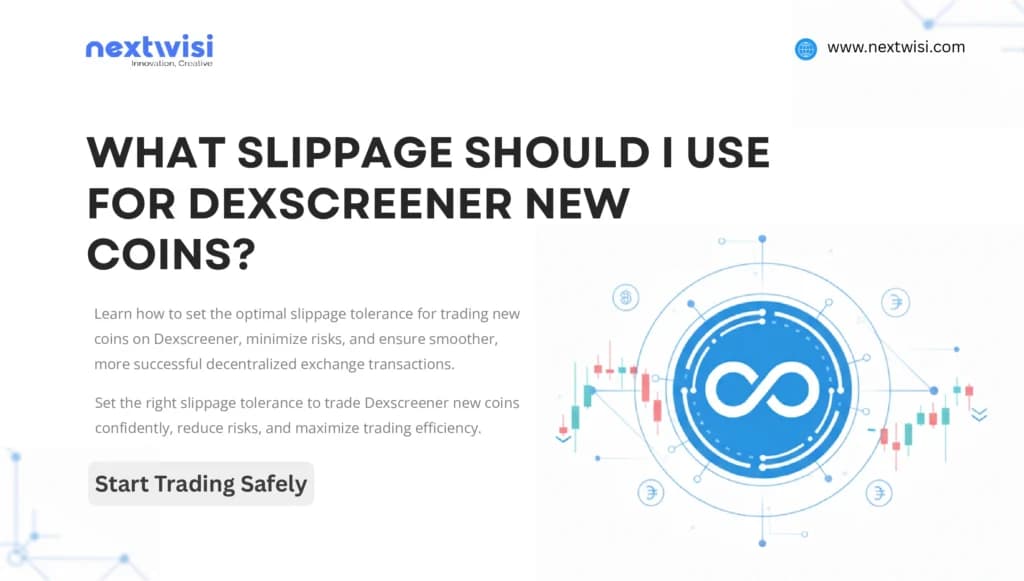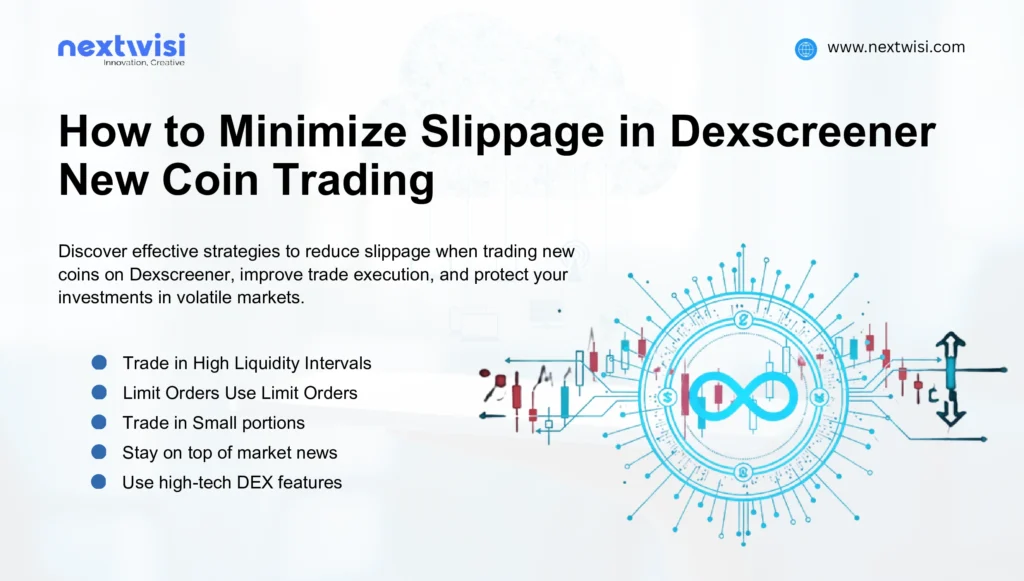By anil
10/24/2025

Trading of new coins on a decentralized exchange (DEX) is a good profit-making undertaking, yet it has its challenges. Slippage tolerance is one of the most critical items towards successful trades. When you are inquiring, “What slippage should I use for the Dexscreener new coin?” this guide will furnish you with a comprehensive and practical solution to guide you to open your trades effectively with minimum risks involved.
Slippage tolerance is the percentage of price change that the trader is prepared to accept at the time of making a trade on a DEX. Exchanges such as Dexscreener are decentralized, so it is possible that over a short period of time between the time you submit an order and its execution, prices may increase or decrease rapidly. Adjusting a correct slippage tolerance, which will make your transaction complete without any significant losses caused by the rapid variations of prices.
Slippage is even more imperative when trading new coins on Dexscreener since such tokens are usually poorly liquid and can frequently undergo substantial and abrupt fluctuations in prices. The appropriate slippage tolerance may help to avoid unsuccessful transactions and, at the same time, not to pay too high prices than planned.
Slippage may directly affect the results of your trades, particularly with new coins that are released. New tokens tend to be less active on the market and be vulnerable to price manipulation or sudden spikes. Failure to control the slippery situation may subject you to lost trades, increased expenditures, or some unforeseen losses. The traders should be cautious of slippage so as to enter into a trade in a manner that it is executed effectively, and at the same time they will be in control of the risks they might face.
Further, the price can move to a very different point of bigger trades when low liquidity occurs. The ability to trade in volatile conditions successfully, even with a slippage tolerance set, is necessary in Dexscreener new coin trading.
1. Market Liquidity
A trading pair has a high degree of liquidity that will affect slippage. When the coins are highly liquid and buy and sell orders are numerous, the slippage can be tolerated with a lower limit, usually 0.5 to 1%. Conversely, low liquidity coins are more tolerant of slippage and sometimes can be as high as 5 percent to guarantee that your trade goes off correctly. Trading volume and order book depth should always be checked before trading on a new coin.
2. Trade Size
Slippage is also dependent on the size of your trade. Greater trades on low liquidity tokens have a higher probability of shifting the market price and thus, increased slippage. When this happens, then it would be wise to place a higher tolerance so that your entire order can be filled. Smaller trades, on the other hand, can typically be traded with minimal slippage, meaning you can put a lower tolerance in place.
3. Market Volatility
New coins are usually sensitive, and the price may vary wildly within a short time. Caught unawares may be the sudden price movements triggered by news events, social media hype, or sudden changes in trading activity. In such periods, you can raise your slippage tolerance a bit to ensure that you still have the ability to trade without the needless cancellations and be able to handle the unforeseen losses.
4. Start Conservatively and Adjust Gradually
In case you are not sure of the right slippage to apply to a new coin, you can be conservative with 1 percent toleration or 2 percent. Check the outcomes of your trade execution, and you can slow down the slippage progressively when the orders are frequently failing. This approach would strike a balance between safety and efficiency and minimize the possibility of paying a lot of money in the turbulent environment.
5. Utilize DEX Tools and Alerts
The majority of DEXs have analytics, price alerts, and slippage adjustment features that allow traders to make informed choices. The tools give you a view of recent price movements, liquidity, and possible risks to allow you to establish a slippage tolerance that would be in line with market conditions. Trading with the help of these resources can make you more successful.
The liquidity of the token, its trading volume, and market volatility are very important factors in determining the best slippage that new coins can have on Dexcreener.
High Liquidity Coins: In the case of coins with high liquidity, the tolerance of slippage of 0.5%-1% is usually appropriate since the trade can be completed without a big price variation or delay.
Moderate Liquidity Coins: Moderate liquidity coins should have a slippage of 1-2% to ensure smooth execution of the trades and control any possible price fluctuations.
Low Liquidity Coins: When dealing with low liquidity tokens, a slippage tolerance of between 2% and 5% will be appropriate to ensure that trades are successful even in times when the market is extremely volatile.
These are not rigid rules but general guidelines. Set trade size, market activity, and risk tolerance.

Although it is not possible to avoid slippage, it is possible to minimize its effect by applying tactical strategies and trade planning.
Trade in High Liquidity Intervals: Trades should be made at the most active time of the day when the trading volume is high and, therefore, the prices remain stable and there is less major slippage.
Limit Orders Use Limit Orders: Limit orders have you set the price, exactly, at which you will be willing to buy or sell at, and they reduce excessive slippage but may slow down execution.
Trade in Small portions: Big trades can be split into smaller amounts to reduce this effect on the market price to minimize slippage of low liquidity tokens.
Stay on top of market news: Knowing about announcements, or tokens appearing or disappearing, or social media buzz can get you to adjust the tolerance to slippage in time to prevent being caught by abrupt price fluctuations.
Use high-tech DEX features: More sophisticated DEX systems, such as Dexscreener, use slippage optimization, real-time price tracking, and order tracking features to make trading more efficient and more precise.
Slipping can be controlled better by using these strategies and will provide a smoother trade and reduce the losses when trading new coins on Dexscreener.
Development firms that are professional DEX developers can assist in the eventual development of a decentralized exchange that is designed to manage slippage very well. They come up with order matching algorithms, liquidity pool management, and dynamic slippage configuration so that the trades could be done at reasonable prices with the least loss. The next-generation trading platforms may also provide alerts, analytics, and the automatization of adjustments to allow the traders to establish the right slippage tolerance of the new coins.
In the case when you do not know what slippage you should use in Dexscreener for a new coin, select a platform supported by a professional DEX development company, and then it will be more convenient to trading with a minimal number of risks of executing trades.
Examine Token Liquidity: It is always prudent to have a look at the trading volume, depth of the order book, and recent market action before deciding on the slippage tolerance when it comes to any new coin.
Start with Conservative Settings: This is where you should start with a smaller slippage tolerance between 1-2 percent and increase progressively depending on the success and execution of your trades.
Adjust for Trade Size: When using large trades on low liquidity coins, the slippage tolerance might need to be adjusted as well, to get your whole order filled.
Keep Track of Price Movement: By noticing sudden price movements, market indicators, and general price volatility in the market constantly, you will be able to adjust your slippage tolerance efficiently whenever trading.
Use Platform Tools: Take full advantage of Dexscreener analytics, alerts, real-time price tracking, and other platform tools to optimize slippage for safer trades.
However, when you adhere to these practices, it will be possible to trade in new coins more effectively and reduce the risks and unanticipated losses, which may occur in the market under the influence of sudden fluctuations in the market.
Conclusion
The ability to learn and control the tolerance to slippage is entirely paramount to the successful trading of the new coins within the Dexscreener and the minimization of the losses that are unneeded. Traders may also maximize the trade execution and avoid failed trades and ensure unforeseen price changes by ensuring they carefully answer the question, “What slippage should I use for Dexscreener new coin?”
Traders can selectively reduce slippage tolerance by trading in relation to such variables as liquidity, size of trade, and volatility in the market, using the available platform tools. Appropriate slippage management guarantees the trading of new coins is going to be a more predictable and more enjoyable experience, possibly profitable, within the high-paced decentralized exchange space.
Read Another Post – Why Slippage Control Matters for Decentralized Exchange Traders?